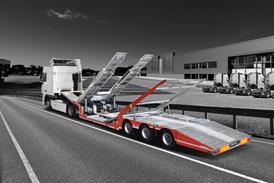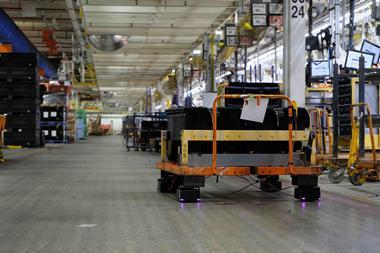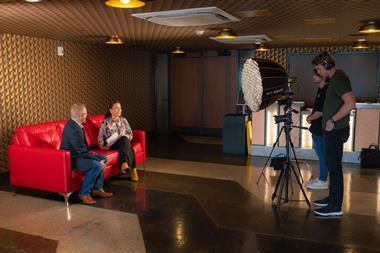Carmakers are embracing the latest digital technology to make their supply chains more resilient but that technology has to be aligned with the right talent, and that depends on a motivational corporate mindset that embraces innovation, experimentation and failure. It also depends on a strong foundation in data and workflow management.

At this year’s ALSC Digital Strategies North America conference in Nashville, Tennessee, Becca Adam, product line manager for material and vehicle logistics IT at Ford, outlined three guiding principles her department worked on to enable an integrated end-to-end supply chain supported by digital technology.
Adam said it was critical for any large company wanting to succeed as a digitally enabled enterprise to first define a shared vision, then invest in foundational systems and data, and look at the priorities governing that investment, with a focus on the users of logistics and supply chain operations. Companies also need to align their technology roadmap with their talent strategy and communicate continually with the workforce on the shift in ways of working with the new technology.
Dedication for collaboration
Defining a shared vision is based on close collaboration between business and IT teams, and supporting third-party vendors, according to Adam. That collaboration depends on having dedicated product managers who are completely committed to digital tooling and who understand how it will enable a business to fulfil its capabilities and what they can do for the team.
Teams also need space to innovate and experiment. “We need to make sure people are staying creative, we have to allow them room to move, room to experiment,” said Adam, adding that included room for ‘fail fast’ trial and error projects designed to quickly determine and assess the long-term viability of a product or strategy. She said that proof of concept was absolutely key to a successful adoption of new technology.
“Not having room to move demotivates people and it also doesn’t get you the best solution in many cases,” noted Adam. “It is about being vulnerable, letting people make mistakes and not hyper-penalising them for that mistake. Those things have to exist in your organisation to really drive innovation, especially in digital.”
Adam said that proven concepts had to be communicable and understood up through the organisation to leadership if they are to succeed and be adopted, and she said that the careers of digitally minded business leaders have skyrocketed over the last decade.
“The people who have that vision and are really energised, and want to talk to you – those are the people who are going to excel so much in their career, and those are the people that you want to hang on to,” said Adam.
“Not having room to move demotivates people and it also doesn’t get you the best solution in many cases. It is about being vulnerable, letting people make mistakes and not hyper-penalising them for that mistake. Those things have to exist in your organisation to really drive innovation, especially in digital” – Becca Adam, Ford
Data management
Investment in foundational systems and data rests on correctly identifying the capabilities technology has to offer. That includes understanding and modernising core value chain execution systems and recognising that data management around those systems underpins their successful application.
“It can’t be seen as an afterthought,” said Adam. “I don’t want to talk to a vendor after selection about how they can provide us data through event streaming services, as an example. I want that to be a key part of the discussion upfront. This is key for large organisations.”
Large, complex companies made up of several business units and working at scale across regions need accurate data management to succeed, something Adam said Ford was embracing not just from an integration standpoint, but also in terms of operational real-time visibility.
“We’re thinking about how do we integrate our digital twin data into that layer as well,” she said. “How can we actually enable real centralised decision making in our supply chain? We think that’s all enabled by that data management layer.”
Read more articles and watch video interviews from ALSC Digital Strategies North America
Workflow connections
Digital tools that provide a clear visualisation of the data and apply accurate, real time control tower technology and analytics, enables companies to run ‘what if’ scenario models which is also important, according to Adam.
So is workflow management, especially at large complex organisations, which need to tie core value chain execution systems together. That is not something that can happen innately in one single tool.
“You have to be able to drive decisions throughout those tools and actually have an approval workflow or a way to connect all those business units together,” said Adam. “So how you’re thinking about workflow management as a tech stack solution is also very important.”
With regard to artificial intelligence (AI) Becca warned that it should be applied with care. Businesses are finding new interesting ways to implement AI and Adam’s advised that a first step is pushing on software-as-a-service (SaaS) providers.
“If you have SaaS vendors that you’re working with actively, you should know what the roadmap is for them to integrate generative AI and AI into their platform. That’s something that you really need to know,” said Adam.
Adam said that Ford’s partnership with Google Cloud gave it access to large language models (LLMs) that it can integrate with its core data sets as needed. Selling that to business leaders relies on investment in data management, a “foundational investment to future proof the business so that we can fully encapsulate all the value of AI”, said Adam.
Talent and technology
The final guiding principle Adam talked about was the importance of aligning technology and and talent, and closing the gap between the skill of the workforce and the technology you provided to them, a point that was reiterated throughout this year’s conference.
Adam said it was important to identify the archetypal person that you want to be working in your team in three to four years and what skills they should have.
“What is the archetype you have defined as your future worker?” she asked. “I think a lot of the large OEMs are going through a shift where they have a ton of tribal knowledge that is reaching retirement. That is particularly applicable in the automotive space. So the question is, who is that next employee [and] how do you expect them to interact with your tooling?”
Adam said that it was important to identify future talent and pitch the outline to leadership along with the digital tools they would ideally be using. The next wave of talent will enable connected supply chain view, according to Adam.
“We need to be an attraction in the market to get talent at our organisation,” she said. “I think that’s a view that is sometimes overlooked [but] it’s very important and valuable to sell that to your leadership team.”
Adam appropriately quoted Henry Ford: “If everyone is moving forward together, then success takes care of itself.” That movement forward involves being vulnerable, sharing openly with business and IT stakeholders, and building strong, trusting relationships for success, according to Adam.
Read our interview with Becca Adam, which is published in the summer edition of Automotive Logistics magazine, in which she talks aboiut the carmaker’s use of digital twin technology for inbound material flow, integration of real-time location services in vehicle management, and the focus on data management in logistics

























![Global[1]](https://d3n5uof8vony13.cloudfront.net/Pictures/web/a/d/s/global1_726550.svgz)














No comments yet